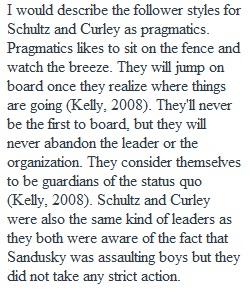


Q For this question, you are presented with a Case Study Download Case Study. Please read and answer the questions below. Also, use the seminar readings below to inform your responses to the questions posed. Seminar Readings Kelly, R. E. (1988). In praise of followers. Harvard Business Review, 66(6), 141-148. Kelly, R. E.. (2008). Rethinking followership. In R. Riggio, I. Chaleff, J. Lipman-Blumen (Eds.), the art of followership: How great followers create great leaders and organizations. (pp. 5-16). San Francisco, CA: Jossey Bass. (see https://www.google.com/url?sa=t&rct=j&q=&esrc=s&source=web&cd=13&ved=2ahUKEwiQgterg_XkAhVRrJ4KHRILDLoQFjAMegQIBBAC&url=https%3A%2F%2Fwww.asme.org.uk%2Fimages%2Fpdfs%2F2013%2F8.rethinking_followership.pdf&usg=AOvVaw3oiIOSDRDNwyGlmRMl-D8K (Links to an external site.) Lipman-Blumen, J. (2005). The Allure of Toxic Leaders: Why Followers Rarely Escape their Clutches. Ivey Business Journal, See https://www.google.com/url?sa=t&rct=j&q=&esrc=s&source=web&cd=1&cad=rja&uact=8&ved=2ahUKEwiw0f_PhPXkAhXGqZ4KHZkSA5cQFjAAegQIABAB&url=https%3A%2F%2Fiveybusinessjournal.com%2Fpublication%2Fthe-allure-of-toxic-leaders-why-followers-rarely-escape-their-clutches%2F&usg=AOvVaw0KBJ2Gq-PpDuyaKtShsOXL (Links to an external site.) Questions: 1. Using Kelly’s (1998, 2008) Typology, how would you describe the follower styles for Schultz and Curley? What about McQueary? 2. How did followers in this case study act in ways that contribute to the power of destructive leaders and their goals? What was the debilitating impact their actions had on the organization? 3. In the end, who carries the burden of responsibility regarding the failure of Paterno’s program – the leaders or the followers? Defend your answer. Post your answers to the Reply area. This is the first part of your submission, click Next to access the second part.
View Related Questions